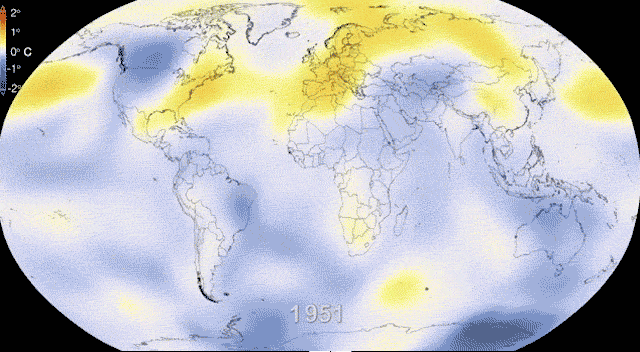
“Climate Change” is a buzzword nowadays. You might have heard the term mentioned at your family’s dinner table last Thanksgiving, or shouted during rallies around the world in the past year. You’ve probably heard statements about it like “it’s a hoax” and “China caused it” or maybe you’ve heard “It’s definitely happening, but it’s a natural process. Nothing to concern ourselves with.” But here’s the truth: Climate Change is happening, and it’s extremely likely that it is our fault.
The Intergovernmental Panel on Climate Change has stated that, “scientific evidence for warming of the climate system is unequivocal.” In fact, according to NASA, 97% of climate scientists are in agreement with that position, as well as most leading scientific organizations worldwide. Michael E. Mann, a professor of atmospheric science at Penn State, has explained that human-caused Climate Change has about the same level of scientific consensus as the Theory of Gravity.

“Scientific evidence for warming of the climate system is unequivocal” – The Intergovernmental Panel on Climate Change.
The Earth’s climate has constantly been changing, and this is completely natural. The majority of the changes are due to extremely small variations in Earth’s orbit that affect how much solar energy Earth receives. (NASA) However, the reason why the current warming trend is concerning is that the warming is happening at an unprecedented rate. It is also a bigger issue because of the fact that it is extremely likely that the warming is a result of human activity. The reason why there is such a huge scientific consensus is because the evidence of a rapid climate change, despite myths circling around, is overwhelming. There is global temperature rise, warming oceans, shrinking ice sheets, glacial retreat, decreasing snow cover, seal level rise, decreasing Arctic sea ice, ocean acidification, and more. (NASA) According to independent analyses by NASA and the National Oceanic and Atmospheric Administration (NOAA), 2016 marks the hottest year ever on record. Not only that, but 2013, 2014, and 2015 all set new records for global average surface temperatures. The National Snow and Ice Data Center say that, over the past century, the majority of the glaciers around the world have retreated at “unprecedented rates”. Data from NASA’s Gravity Recovery and Climate Experiment show that Greenland has lost 36-60 cubic miles of ice per year between 2002 and 2006, and Antarctica has lost 36 cubic miles of ice between 2002 and 2005. Also according to NOAA, since the beginning of the Industrial Revolution, the acidity of surface ocean waters has increased by about 30%. The effects seem never ending.
The reason for all of these events are due to the unexpected effects of the Industrial Revolution and extreme energy use. For the past few hundred years, we have been burning fossil fuels, like coal, oil, and natural gas, for energy. However, when we burn fossil fuels, greenhouse gases get emitted. A well-known greenhouse gas is carbon dioxide, and some others are methane, nitrous oxide, and water vapor. When we emit greenhouse gases, they accumulate in the atmosphere and trap the sun’s heat, which warms the planet. Warming the planet is definitely a positive, it makes the planet habitable for life, but the increasing levels of greenhouse gases are what is dangerous. Carbon dioxide and other gases’ ability to trap heat was realized back in the 19th century, including a seminal paper by Svante Arrhenius, a Swedish scientist. He predicted that changes in carbon dioxide levels in the atmosphere had the potential to significantly alter the surface temperature of Earth through the greenhouse effect. According to NASA, there is no doubt that increased level of greenhouse gases cause the Earth to warm.

Although all of this information makes the prospect of our planet seem pretty bleak, this is where you come in. There are many ways to help fight climate change. One of the main things to do is to help reduce greenhouse gas emissions. Seth Wynes, a researcher in the Geography Department at the University of British Columbia, and co-author of a new study in the journal Environmental Research Letters, the most significant ways to help reduce emissions are: having less children, not having a car, avoiding transatlantic flights, and eating a mostly vegetarian diets. Although less impactful, well-known solutions like switching to efficient light bulbs and using reusable bags, all add up. However, Wynes recognizes that these changes might be hard. He says “We talk about structural barriers that get in the way of being able to adopt some of these changes… For some people, those lifestyle changes aren’t going to be possible without relocating, and so there are other options that could be chosen.” At this point, we won’t be able to completely stop climate change, but we still have time to avoid the worst effects. However, we need to act now. Try to use renewable energy, like solar powered energy, if possible, or try to be mindful of the food you’re eating and its respective impact on the environment. Speak to policy makers about implementing policies relating to renewable energy and other relevant solutions. Another great way to significantly impact and help fight climate change is by leveraging our collective consumer spending power.
HERE’S WHERE SOLI COMES IN.



What is Soli? Soli is a loyalty app that saves the planet while saving you money. Sounds pretty good, right? And guess what, it’s completely free. By using Soli, for every dollar you spend, you earn 1-5% cash back, while also preventing 2 pounds of carbon dioxide from being sent up into the atmosphere, which would trap the sun’s heat and warm the planet. Not only do you get to help save the planet and earn cash back, the app also offers all kinds of exciting promotions and discounts. You have to shop at participating merchants but no worries. Soli has 4000+ merchants, which makes you almost guaranteed to find a solution in the Soli app for anything you need to purchase. You simply type in the information of your existing debit or credit card into the app one time, and start earning cash back and helping to save the planet!
The way that Soli reduces toxic emissions is that for every purchase you make, the company will pay Soli a commission, which we then use to purchase and retire carbon credits. Carbon credits are permits that allow an organization to emit a certain amount of carbon, and can be traded if not used. So, Soli buys these credits to prevent organizations from using them to produce carbon emissions. Essentially, Soli is helping to limit these harmful emissions into the atmosphere, which warms the planet. According to the World Bank, the average American emits 16.1 tons of carbon per year, much higher than the Paris Climate Accords goal of 2.1 tons. Also, in 2015, according to the United States Environmental Protection Agency, carbon dioxide accounted for 82% of greenhouse gas emissions. So, considering this, reducing 2 pounds of carbon dioxide every time you spent only $1 will lead to a big impact.
The app is currently in beta, so if it sounds appealing to you, go to solisolutions.net and request an invite to download and test the app for yourself!

